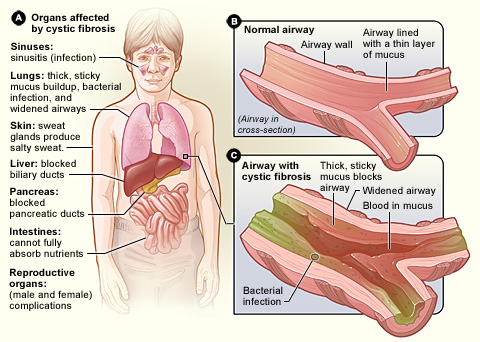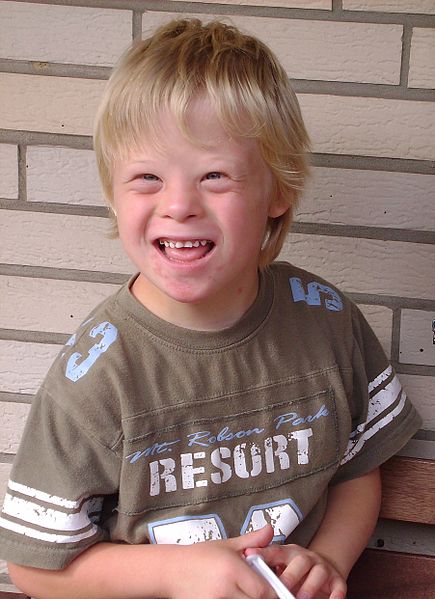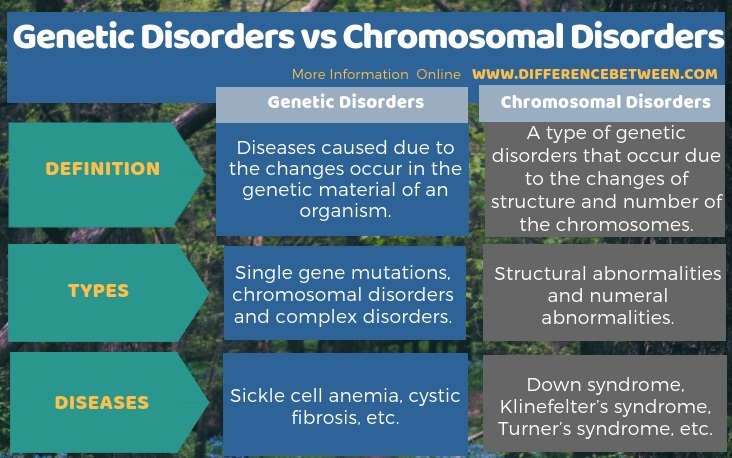Difference Between Genetic Disorders and Chromosomal Disorders
The key difference between genetic disorders and chromosomal disorders is that the genetic disorders are the diseases that arise due to the changes occur in the DNA of an organism while the chromosomal disorders are a type of genetic disorders, specifically referred to the diseases that arise due to the changes occurring in structure or number of the chromosomes.
The genome is the repository of the genetic information of an organism. It includes the complete set of chromosomes resides inside the nucleus of a eukaryotic organism or in the cytoplasm of the prokaryotic organism. Since the chromosomes represent the genome and the genetic information of an organism; it is necessary to avoid structural and functional changes take place in the nucleotide sequences of DNA molecules. It can be done by allowing the correct replication process to occur and thus preventing the possible mutations. Otherwise, genetic disorders can arise within the offspring generation as well. Genetic disorders are of three types namely single gene mutations, complex disorders or chromosomal disorders.
CONTENTS
1. Overview and Key Difference
2. What are Genetic Disorders
3. What are Chromosomal Disorders
4. Similarities Between Genetic Disorders and Chromosomal Disorders
5. Side by Side Comparison – Genetic Disorders vs Chromosomal Disorders in Tabular Form
6. Summary
What are Genetic Disorders?
Genetic disorders are diseases caused by the changes occur in the genetic material of an organism. When the alterations take place in the sequences of the DNA molecules, they result in wrong proteins. which fulfil wrong functions. In the end, different kinds of genetic diseases appear in the organisms. Structurally, there are three types of genetic disorders. They are single gene disorders, chromosomal disorders and complex disorders. As a result of single gene mutation, genetic disorders such as sickle cell anaemia and cystic fibrosis may result.

On the other hand, complex disorders occur due to a combination of many factors such as multiple genes, environmental factors, lifestyle factors, etc. Apart from these two types, chromosomal disorders are the third type of genetic disorder which occurs due to the changes in the chromosomal numbers and the structure. During the chromosomal disorders, big parts of the chromosomes may subject to changes. And also, due to the errors of the cell division process, an abnormal number of chromosomes may obtain by the zygotes which lead to chromosomal disorders. Down syndrome and Turners syndrome are two common chromosomal disorders.
What are Chromosomal Disorders?
Chromosomal disorders are one type of genetic disorders. They refer to the diseases that result due to the changes in the number or structure of the chromosomes. Usually, a cell has a defined number of chromosomes in its genome. In addition to this usual number, some cells can possess an abnormal number of chromosomes due to the errors occur in the cell division process. As a result of these errors, some cells will get an extra chromosome while some cells will end up with one missing chromosome. Trisomy and monosomy are two such types of chromosomal abnormalities. Down syndrome and Klinefelter’s syndrome are two diseases occur in offspring as a result of trisomy while Turner’s syndrome is a result of monosomy. Furthermore, structural changes are also possible in chromosomes due to disruptions and rearrangements.

Although some types of chromosomal disorders can pass from one generation to the next generation, most of the chromosomal disorders are not inheritable. If the chromosomal disorder occurs in the somatic cells instead of germ cells, there is no chance of inheriting it to the next generation. On the other hand, if the chromosomal disorder occurs in a reproductive cell, there is a high possibility of inheriting that particular disorder to the offspring.
What are the Similarities Between Genetic Disorders and Chromosomal Disorders?
- Genetic disorders and chromosomal disorders occur due to the changes in the DNA of an organism.
- Furthermore, chromosomal disorders are a part of the genetic disorders.
- Also,both disorders can be inherited or not.
What is the Difference Between Genetic Disorders and Chromosomal Disorders?
Genetic disorders arise due to the changes occur in the genome of an organism. There are three types of genetic disorders including single gene mutations, complex disorders and chromosomal disorders. Hence, chromosomal disorders are a type of genetic disorders. Especially chromosomal disorders refer to the changes of structure and number of the chromosomes. Therefore, this is the key difference between genetic disorders and chromosomal disorders.
The belows infographic shows the difference between genetic disorders and chromosomal disorders as a side by side comparison.

Summary – Genetic Disorders vs Chromosomal Disorders
A gene is the basic unit of heredity. One chromosome has an array of genes. Accordingly, the whole genome contains thousands of genes. A gene possesses a precisely arranged nucleotide sequence that encodes for a particular protein. However, there is a possibility of changing the nucleotide sequences of these genes that can lead to genetic disorders. Particularly, there are three types of genetic disorders. Among them, chromosomal disorders are one type that results due to the changes in structure and number of the chromosomes. As a summary, genetic disorders are the diseases caused due to the changes in the genetic material while the chromosomal disorders are the diseases caused due to the changes in structure and number of the chromosomes. This summarizes the difference between genetic disorders and chromosomal disorders.
Reference:
1.“Genetic Disorders.” Genetic Alliance UK. Available here
2.“Genetic Disorder.” Wikipedia, Wikimedia Foundation, 19 Sept. 2018. Available here
Image Courtesy:
1.”Cysticfibrosis01″By National Heart Lung and Blood Institute (NIH) – National Heart Lung and Blood Institute (NIH), Public Domain) via Commons Wikimedia
2.”Boy with Down Syndrome”By Vanellus Foto – Own work, (CC BY-SA 3.0) via Commons Wikimedia
ncG1vNJzZmivp6x7pbXFn5yrnZ6YsqOx07CcnqZemLyue8OinZ%2Bdopq7pLGMm5ytr5Wau26zxKecraGTYrGqv86rm56qo2Kur7CMnJ%2Brp52kwLC5wKVknaGjpL%2BlsdGsZg%3D%3D